Idaho is a large state that’s located on the northwestern edge of the lower-48 states of the United States. Despite its spacious area, Idaho is among the least densely populated states. This leaves plenty of space for undisturbed wildlife to flourish.
There are around 300 animal species and 432 species of birds in Idaho. So if you like to explore and enjoy nature, then you’ll be amazed by what you can find there. The mountain ranges, rapid river beds, deep canyons, and huge lakes are all home to some of the most interesting animals in the country.
There are plenty of picturesque wild birds in Idaho, and here are some of our absolute favorites.
Red Birds in Idaho
Scarlet Tanager
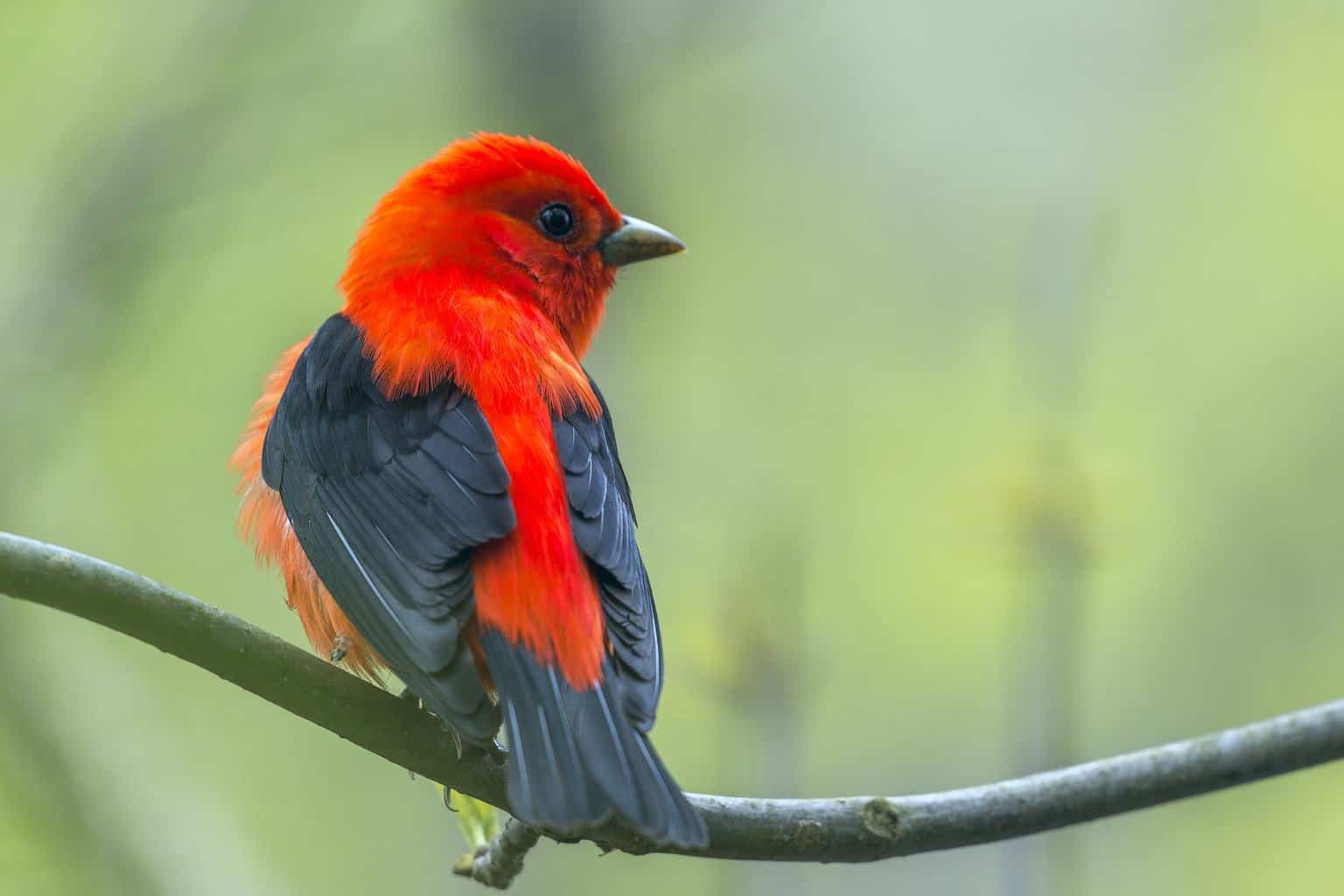
- Scientific Name: Piranga olivacea
- Length: 6.3-6.7 in
- Weight: 0.8-1.3 oz
- Wingspan: 9.8-11.4 in
If you see a male and a female Scarlet Tanager, you might think that they’re two different species. The adult male has deep red feathers all over its body, and coal-black feathers on its wings and tail. Contrary to that bright color pattern, the adult females are pale yellow with grey-colored wings. But they’re both plump little birds with a comely appearance.
Scarlet Tanagers favor living in deciduous forests, where they feed primarily on crawling insects living on the bark.
It might be a bit hard to spot these birds as they often stay on the highest branches in the trees. But they do have a distinctive call, and the flaming red color of the males could make the task a tad easier.
Ring-Necked Pheasant

- Scientific Name: Phasianus colchicus
- Length: 19.7-27.6 in
- Weight: 17.6-105.8 oz
- Wingspan: 22.1-33.9 in
This familiar bird is a favorite subject of painters and photographs. In particular, the male Red-necked pheasant, which has a bright red head, bluish-green neck, a uniquely patterned body, and a long proud tail.
The dandy look is exclusive to the males though, the females are more like large hens with brown feathers. Both males and females are large strapping birds, slightly smaller than a goose.
Pheasants are ground dwellers that live around tall vegetation or brushy areas.
Ruby-Throated Hummingbird

- Scientific Name: Archilochus colubris
- Length: 2.8-3.5 in
- Weight: 0.1-0.2 oz
- Wingspan: 3.1-4.3 in
A bright red throat characterizes the adult male Ruby-throated hummingbird, together with a black head and greenish-colored crown and body colors running from green to white to red at the throat. And like all other hummingbirds, it has a long curved bill that helps it collect nectar from flowers.
This small-sized bird is quite small, barely the size of a song sparrow. but they’re not too hard to spot. That’s because they often live around gardens, meadows, and parks. And if you have a bird feeder in your backyard, a Ruby-throated hummingbird might come and visit.
Red-Headed Woodpecker

- Scientific Name: Melanerpes erythrocephalus
- Length: 7.5-9.1 in
- Weight: 2.0-3.2 oz
- Wingspan: 16.5 in
It’s not hard at all to spot and identify a Red-headed Woodpecker. With its bold colors and distinct calls, you can easily find this medium size bird. It has black wings, a white belly, and the famous red head.
Red-headed woodpeckers are common backyard birds, but they favor aging timber. More so if it grows near swamps or agricultural areas. That’s because these woodpeckers feed on fruits, seeds, nuts, berries from trees, and acorns. Their menu also includes various types of insects like grasshoppers. Timber is the perfect place to store food, and these birds are proficient at the art of warehousing.
Pileated Woodpecker

- Scientific Name: Dryocopus pileatus
- Length: 15.8-19.3 in
- Weight: 8.8-12.3 oz
- Wingspan: 26.0-29.5 in
While most woodpeckers are small in size, the Pileated Woodpecker is a large bird. It’s actually as big as a crow, which would make it easy to spot. You can also tell a breeding adult apart from other birds from the red markings on its head and that red mohawk. Its black plumage color is offset by the white streaks on its cheeks and neck
These woodpeckers feed primarily on insects, and especially the ants that live on tree bark.
You’d find Pileated woodpeckers among dead or decaying trees. And even before you spot one of them, they’d make their presence known by their consistent drilling and drumming on trees with their strong beak.
Blue Birds in Idaho
Indigo Bunting

- Scientific Name: Passerina cyanea
- Length: 4.7-5.1 in
- Weight: 0.4-0.6 oz
- Wingspan: 7.5-8.7 in
Indigo Buntings are often given the nickname “blue canaries”, and it’s not hard to guess why. They look incredibly cute with the bright blue color and comely features. In addition, they sing a beautiful song to the whole world in the spring and summer seasons.
These birds aren’t rare, but they tend to nest and perch on the highest branches of tall trees so actual bird sightings are not common. That’s also where they find delicious meals of bark insects. You can also entice them to a backyard feeder with the right kind of seeds.
These migratory birds only travel at night, and there’s an interesting reason for that. They’re adept at using the stars as navigation tools.
Lazuli Bunting
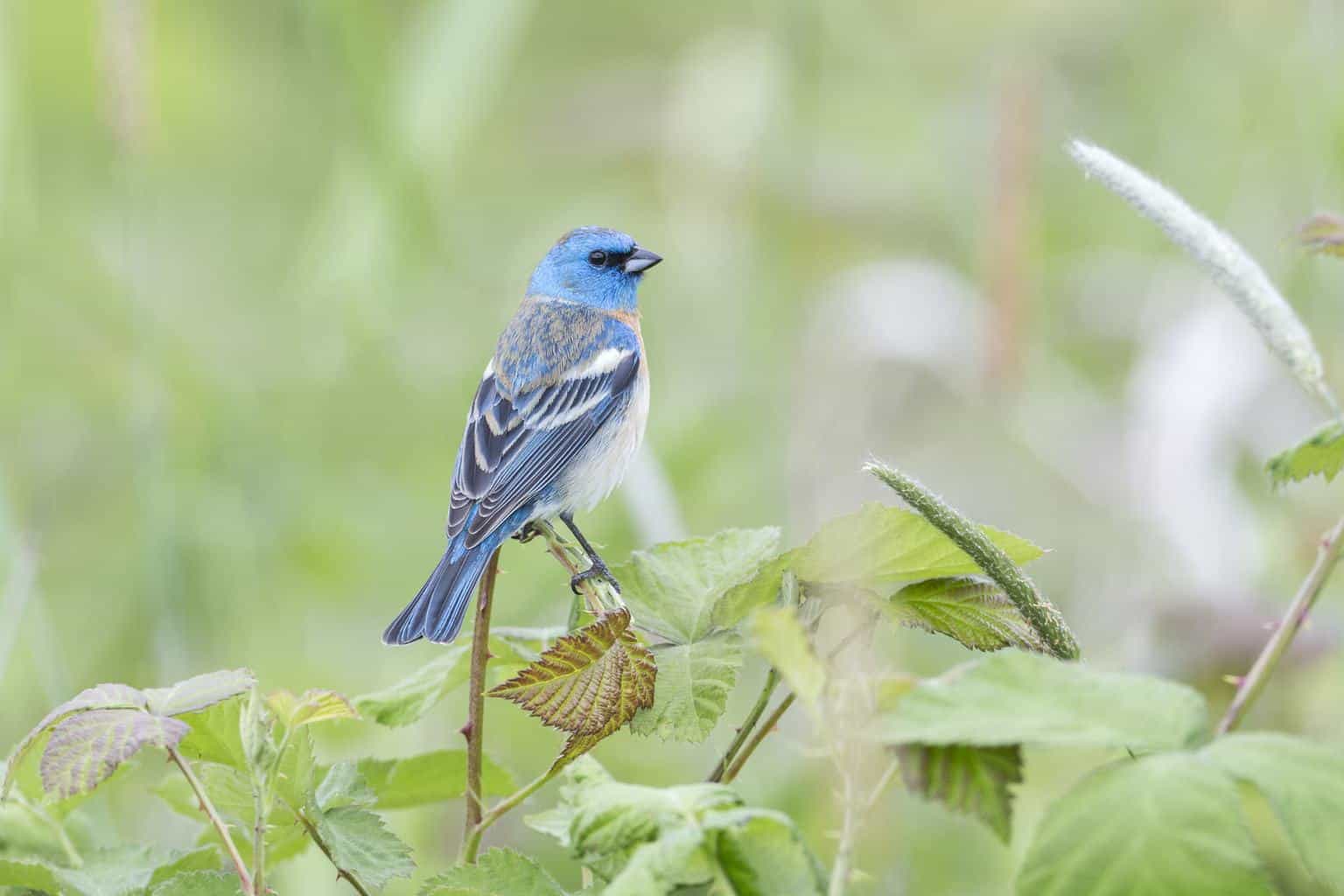
- Scientific Name: Passerina amoena
- Length: 5.1-5.9 in
- Weight: 0.5-0.6 oz
- Wingspan: 8.7 in
Male and female Lazuli Buntings couldn’t be more different in their appearance, with the male hogging all the brighter colors and prominent physical features. They have a blue head and back, black beak, with white and black streaks on their wings, a brown chest, and a white belly. The one thing they have in common is their slim split tail.
These birds often forage at high branches, but they’re social birds, singing, and perching on the lower branches in the understory of forests.
Mountain Bluebird

- Scientific Name: Sialia currucoides
- Length: 6.1-7.1 in
- Weight: 0.85-1.31 oz
- Wingspan: 11.0-14.2 in
Mountain Bluebirds are plump little birds with the nicest sky blue colors for the breeding males, and lighter tones for the females. They are completely different from the bluejay, or jay bird, as they are sometimes called.
These native birds forage on insects, berries, and any other goodies they can find around shrubs. They’re often found in open country, tundra, steppes, and prairies.
Mountain birds aren’t shy of humans, so you could easily find them in urban parks, ranches, or invite them to your backyard feeder.
Blue Grosbeak

- Scientific Name: Passerina caerulea
- Length: 5.5-7.5 in
- Weight: 0.92-1.11 oz
- Wingspan: 10-11 in
The deep blue color of the Blue Grosbeak male is quite vibrant. And if that’s not enough, its hawkish head and beak are foolproof identifiers. It also has black wing bars. The females are cinnamon-colored and well-proportioned.
These birds are loners and they live on the outskirts of woods. You can often hear their bird songs and tinny calls before spotting them.
Tree Swallow
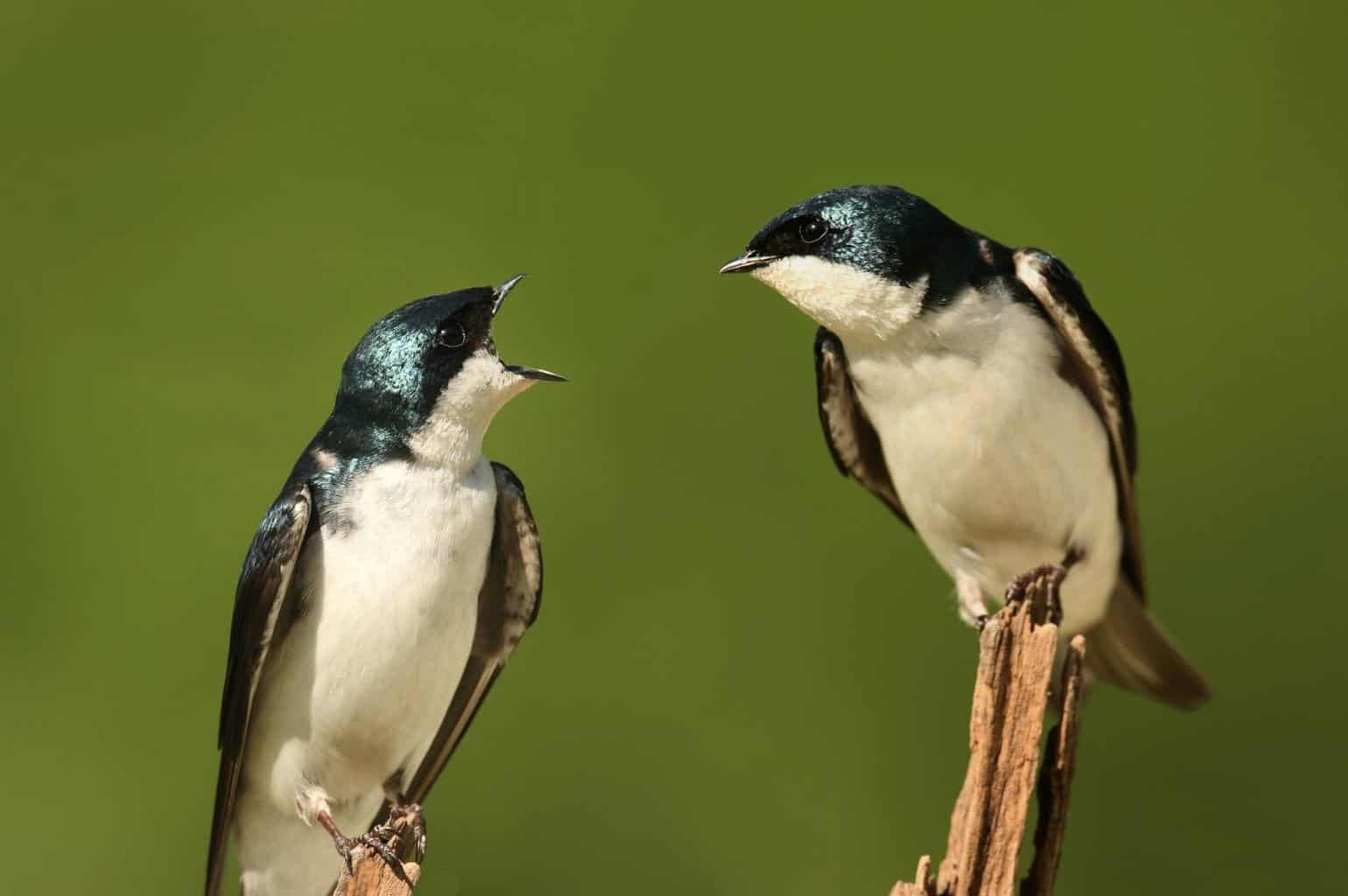
- Scientific Name: Tachycineta bicolor
- Length: 4.7-5.9 in
- Weight: 0.6-0.9 oz
- Wingspan: 11.8-13.8 in
The metallic petrol-blue of Tree Swallows is rather unique. And if you ever see this beautiful songbird flying, you’ll notice that its wings and tails are nicely shaped and black.
These birds live in rather large flocks both during the breeding season and afterward. They usually show off their flying skills in aerial acrobatics. And if they find an insect flying by, they’d catch it and eat it mid-air.
Tree swallows like living beside water bodies, so wetlands are good places to look for them. And if that’s not feasible, you might find them in agricultural areas.
Green Birds in Idaho
Northern Shoveler

- Scientific Name: Spatula clypeata
- Length: 17.3-20.1 in
- Weight: 14.1-28.9 oz
- Wingspan: 27.2-33.1 in
A bright green head, a big black bill, and patterned tail feathers make the males of the Northern Shoveler easy to identify. The females are quite different in coloring, size, and general shape.
These birds seem to have a voracious appetite and spend most of their time head down in shallow waters in search of food. Their spoon-like bills help as this bird forages for aquatic invertebrates, seeds, and little crustaceans from the water.
Northern Shoveler couples are pretty tight, and this species is among the monogamous birds that stay with their mates for the longest possible time. This is usually from the breeding season all the way till just before migration. Then they split.
Mallard
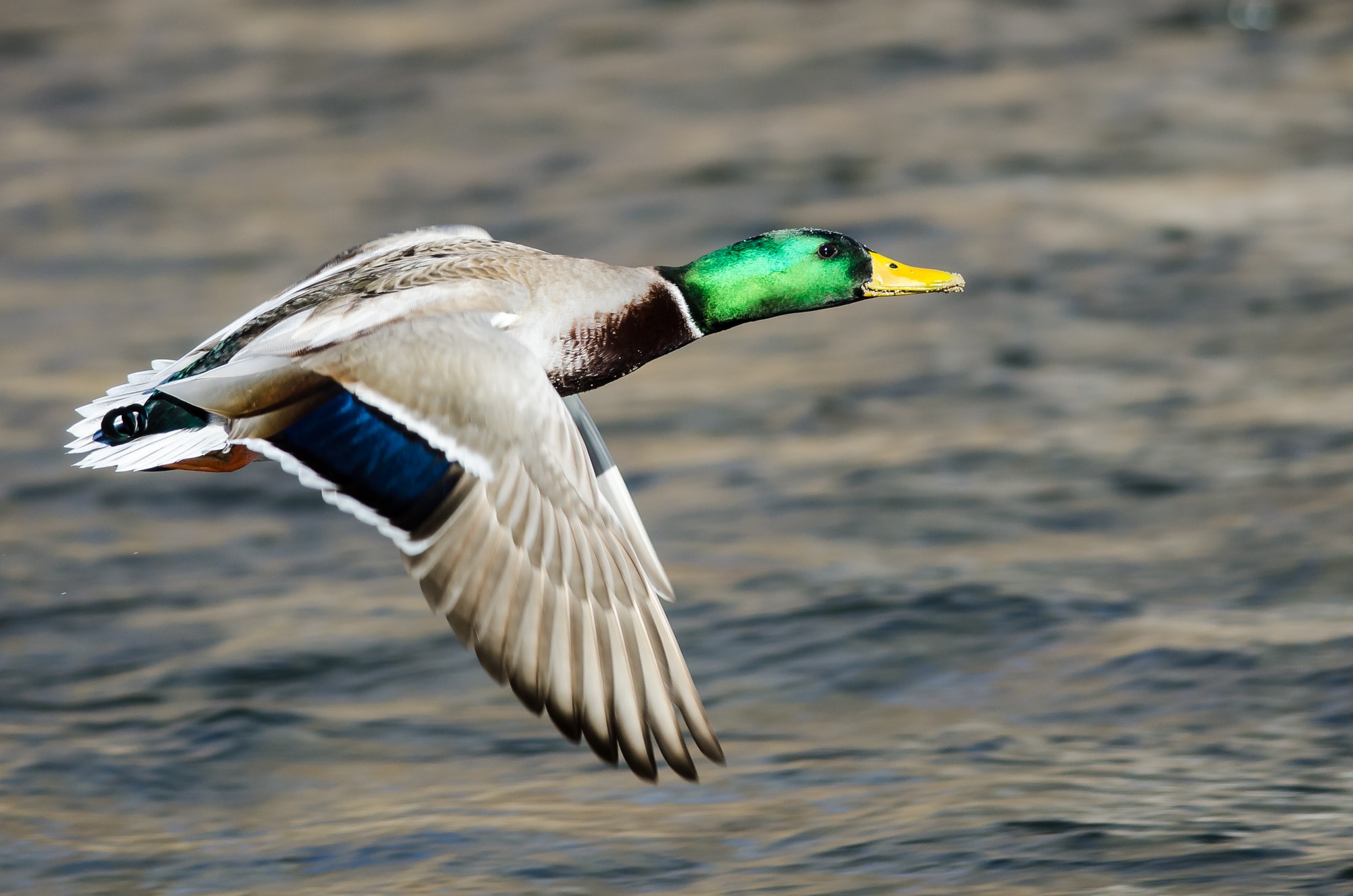
- Scientific Name: Anas platyrhynchos
- Length: 19.7-25.6 in
- Weight: 35.3-45.9 oz
- Wingspan: 32.3-37.4 in
Mallards have green heads like the Northern Shovelers, but they have a more metallic tone. Also, the rest of their coloring is quite different. They have mostly tan bodies with black tails and blue feathers fringing their wings. If you were to ask yourself, “what does a duck look like?” you would think of this family of birds.
These adaptable birds are quite docile and sociable, and you can see them floating happily around ponds in cities. They aren’t too picky about their living arrangements, and any shallow water body is often good for them. They will live in ponds in city parks if they’re suitable and they have been known to show up in the backyards of bird lovers looking for leftover food. You could even find one in a swimming pool!
Mallards are believed to be the parents of many common subspecies including domestic ducks.
Greater Scaup
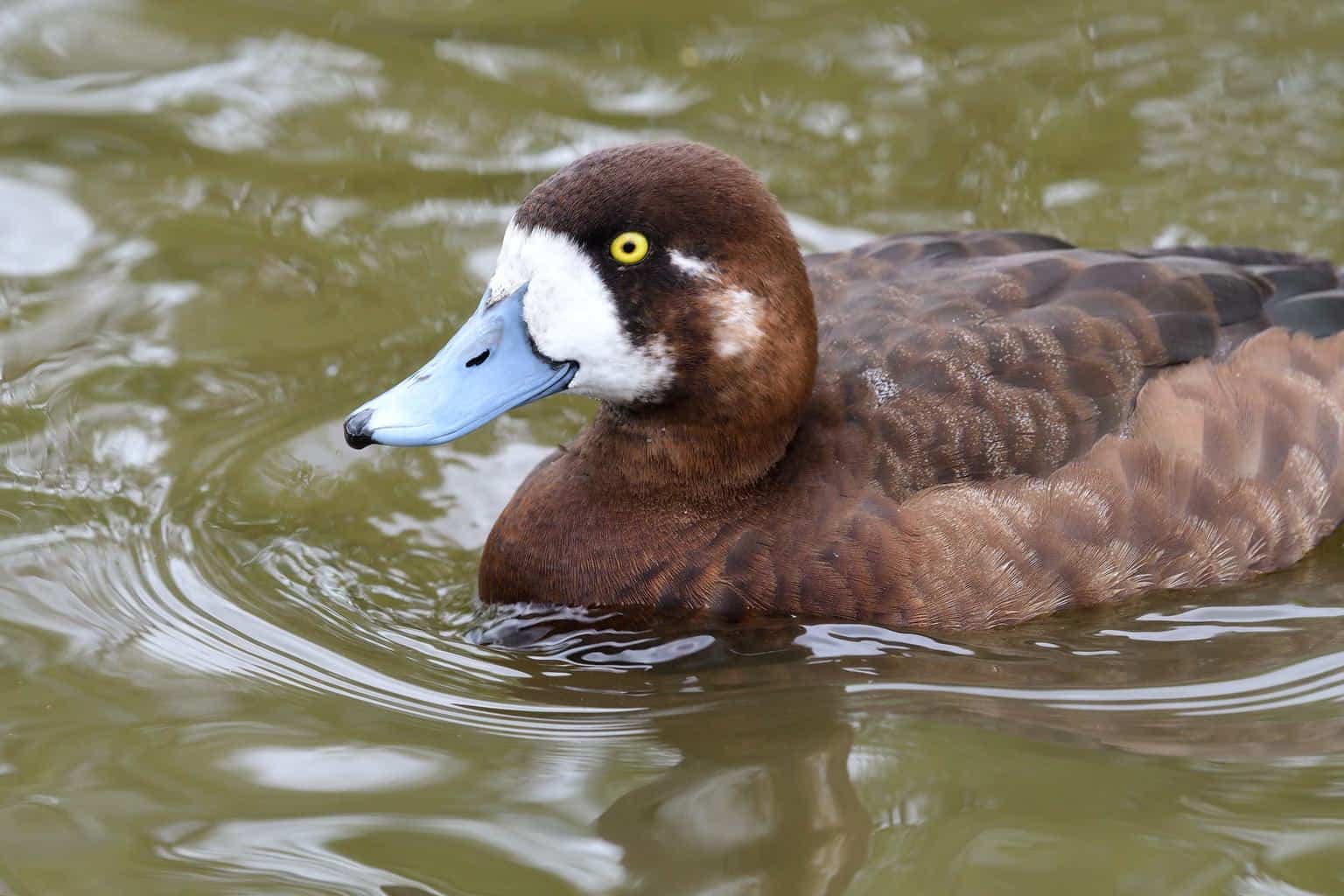
- Scientific Name: Aythya marila
- Length: 15.3-22.1 in
- Weight: 25.6-48.0 oz
- Wingspan: 28.4-31.1 in
The Greater Scaup completes the green-headed duck trio together with Mallards and Northern Shovelers. This one has a rounder and larger head with a much darker green cast. It’s also smaller in size than the other two.
Scaups are diving ducks that often flock around the shores of seas and lakes. Occasionally, they live in water reservoirs. You’d rarely see these ducks alone, as they usually gather in hundreds and even thousands.
They’re usually quite far from the shore though, and spotting them often means going into the water. Or you can use a telescope to observe their activities.
Hooded Warbler
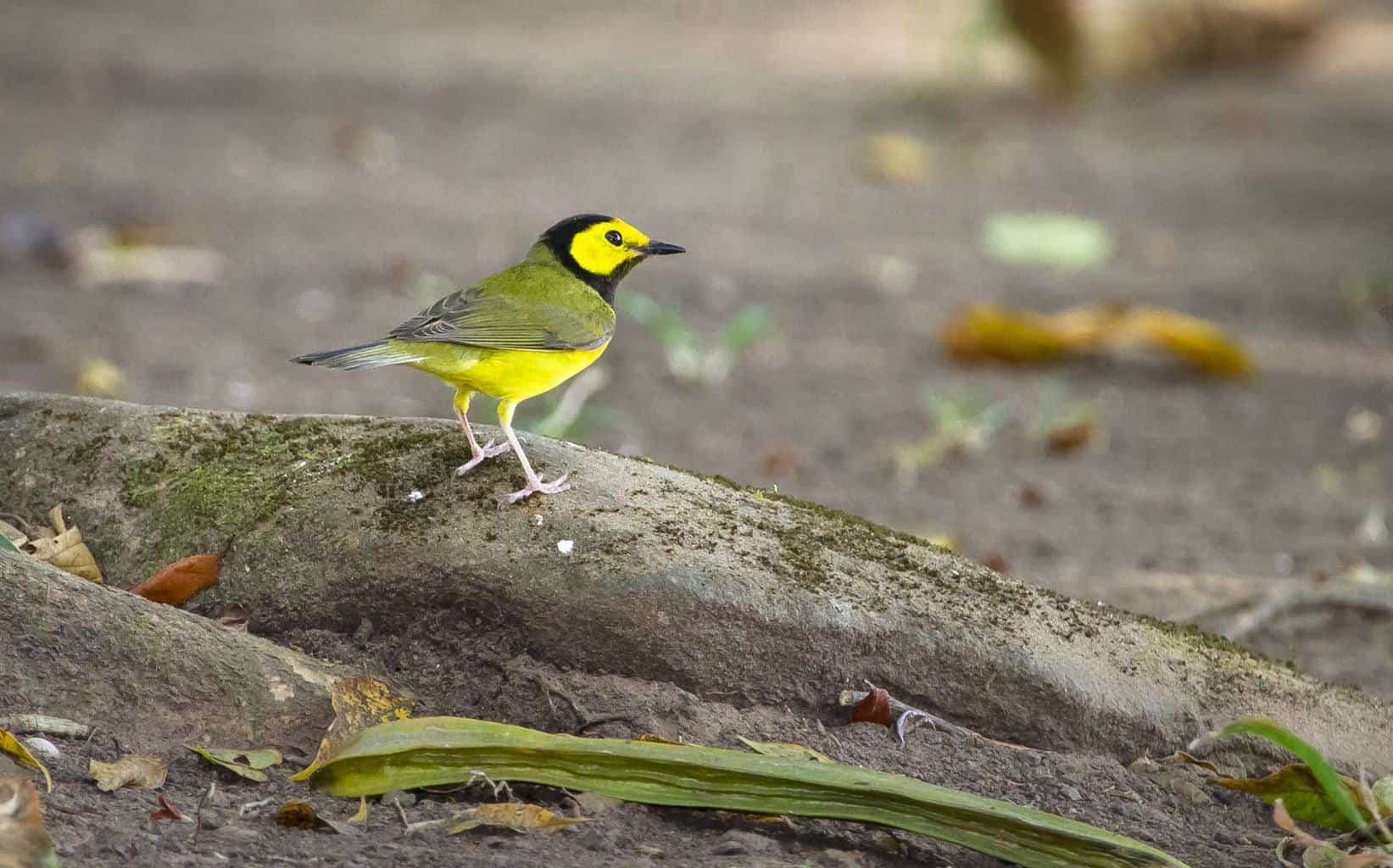
- Scientific Name: Setophaga citrina
- Length: 5.1 in
- Weight: 0.32-0.42 oz
- Wingspan: 6.9 in
Hooded Warblers are plump little birds with pistachio-green backs, yellow bellies, and dark heads with black “hoods” and yellow masks. The females are similar in appearance, but they don’t have black head or throat markings.
You can find these birds in the lower branches of trees, as they spend their time foraging for flying insects and singing.
These birds normally don’t take to backyard feeders. So if you want to attract a hooded warbler, the best way is to create an understory-like shrub around the tall trees in your garden.
Orange Birds in Idaho
Bullock’s Oriole

- Scientific Name: Icterus bullockii
- Length: 6.7-7.5 in
- Weight: 1.0-1.5 oz
- Wingspan: 12.2 in
A Bullock’s Oriole bird is roughly the size of a robin. The male of this common bird species is characterized by a bright orange body, black and white wing bars, and black markings on the back, throat, and a sharp line adjacent to the eyes.
If you happened to see an odd nest and a little orange bird hanging upside down beside it, then that’s Bullock’s oriole. This bird is also a chatty small-sized songbird, so they’re not too hard to find.
Orioles like nectar and fruits, and many bird-watchers offer them a cocktail of both to attract them to their gardens.
Varied Thrush

- Scientific Name: Ixoreus naevius
- Length: 7.5-10.2 in
- Weight: 2.3-3.5 oz
- Wingspan: 13.4-15.0 in
An adult male Varied Thrush is almost the size of a robin, and just as plump. It has an orange belly, patterned black and orange back, and a sharp black marking on its crown and across its eyes. The females have a similar appearance, but with diluted colores.
These colorful birds feed primarily on insects, fruits, and nuts. That’s why you’ll often see them hopping on the ground or perching on low-hanging branches in shrubs. Otherwise, they’ll fly into dense forests for nesting.
Red Crossbill

- Scientific Name: Loxia curvirostra
- Length: 7.9 in
- Weight: 1.4-1.9 oz
- Wingspan: 10.6-11.4 in
The adult Red Crossbill is a stocky bird with a large head and thick bill. It doesn’t have the brightest colors out there. Its body plumage color is mostly orange, except for the edges of its wings, which are rusty brown and it has brown color patches on its cheeks.
The females are drastically different in every way. They have round yellow bodies with grey patterns all over. They do however share the overlapping curved bills with the males.
Crossbills are active birds that move about from the ground to conifer treetops, and if they feel like visiting feeders they won’t think twice.
They typically feed on conifer seeds, but they wouldn’t say no to oil sunflower seeds or grit. They’re often seen with a flock singing, foraging, and generally looking jolly.
Yellow Birds in Idaho
Wilson’s Warbler

- Scientific Name: Cardellina pusilla
- Length: 3.9-4.7 in
- Weight: 0.18-0.35 oz
- Wingspan: 5.5-6.7 in
This chubby little beautiful bird species is absolutely picturesque with its cute all-yellow appearance and beady black eyes. It has a black spot on its head that looks like a toupee. The male and female Wilson’s Warblers are quite similar, but the males have a small black crown.
These birds are rather restless, and you’ll often see them flying between branches and hopping on the understory brush. They like to stay close to thick foliage, as this is where they usually find the best insects.
As for nesting, Wilson’s Warblers are among the few species that build their nests on the ground. Being that accessible, the fledglings often return to the nest after they fly out of it. They don’t repeat this too often though, just for a couple of nights before leaving for good.
American Yellow Warbler

- Scientific Name: Setophaga petechia
- Length: 3.9- 7.1 in
- Weight: 0.25-0.88 oz
- Wingspan: 6.3-8.7 in
American Yellow Warblers look a lot like Wilson’s Warblers, and some birdwatchers get them mixed up. The black cap on males and the greenish backs of females are probably the best ways to tell them apart. They also have light brown streaks on their bellies.
These warblers are singing birds with mellow voices, and it’s usually the males who bellow out melodic whistle-like tunes.
They don’t stay too long in one spot, and you’ll often see them hopping from one branch to the next. Short trees and shrubs are their usual hangouts, as this is where they can catch savory caterpillars and insects.
Western Meadowlark

- Scientific Name: Sturnella neglecta
- Length: 6.3-10.2 in
- Weight: 3.1-4.1 oz
- Wingspan: 16.1 in
The Western Meadowlark is a medium-sized American songbird, roughly as big as a Robin. They have distinctive patterns on their backs and wings, a bright yellow belly, and a unique black V-shaped mark on their chests.
The females are similar to the males but lack the V-mark and have fewer yellow feathers on their undersides. They’re also a tad smaller, and leaner.
These common birds are often seen alone, hopping on the ground, foraging for food. But during cold winters, these native birds usually get a bit more company, and you can see them hanging out with a small flock.
Yellow-Throated Vireo
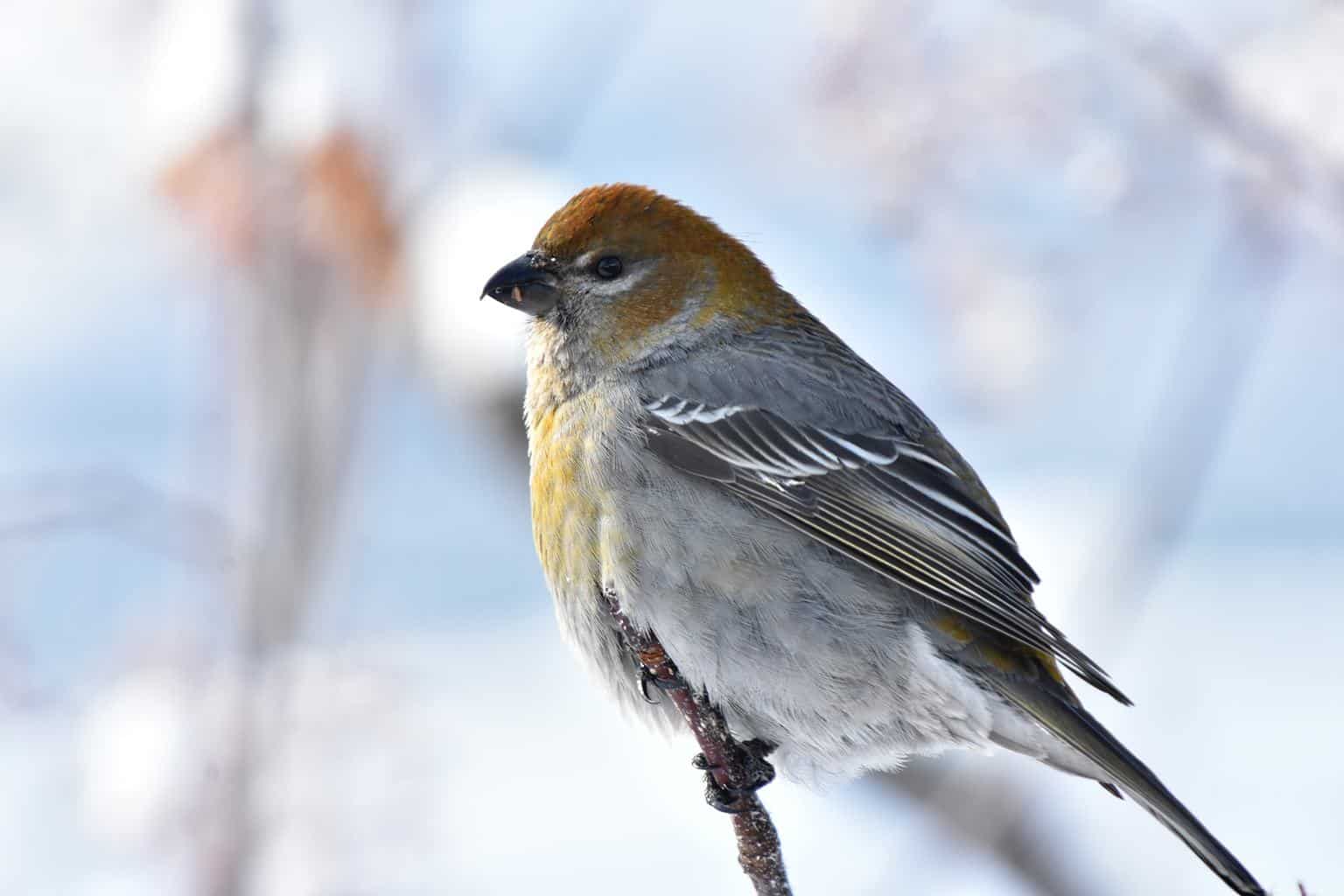
- Scientific Name: Vireo flavifrons
- Length: 5.1-5.9 in
- Weight: 0.5-0.7 oz
- Wingspan: 9.1 in
The Yellow-throated Vireo has a bright yellow chest, but what makes it stand out is the spectacle-like mark around its eyes. It’s rather small, even a well-fed adult bird is barely the size of a sparrow, but larger than a Black-capped Chickadee.
These birds feel most comfortable on high treetops. This bird breeds in deciduous forests, but they prefer spots nearest the woodland edge, where they can find a nice understory as well.
Vireos rarely need to fly too far from their comfort zones in the forests. Their favorite food is the insects that dwell on tree branches, so there’s barely any motive for them to leave the easy food and explore unfamiliar territories.
Other Birds To Watch For in Idaho
Rock Pigeon
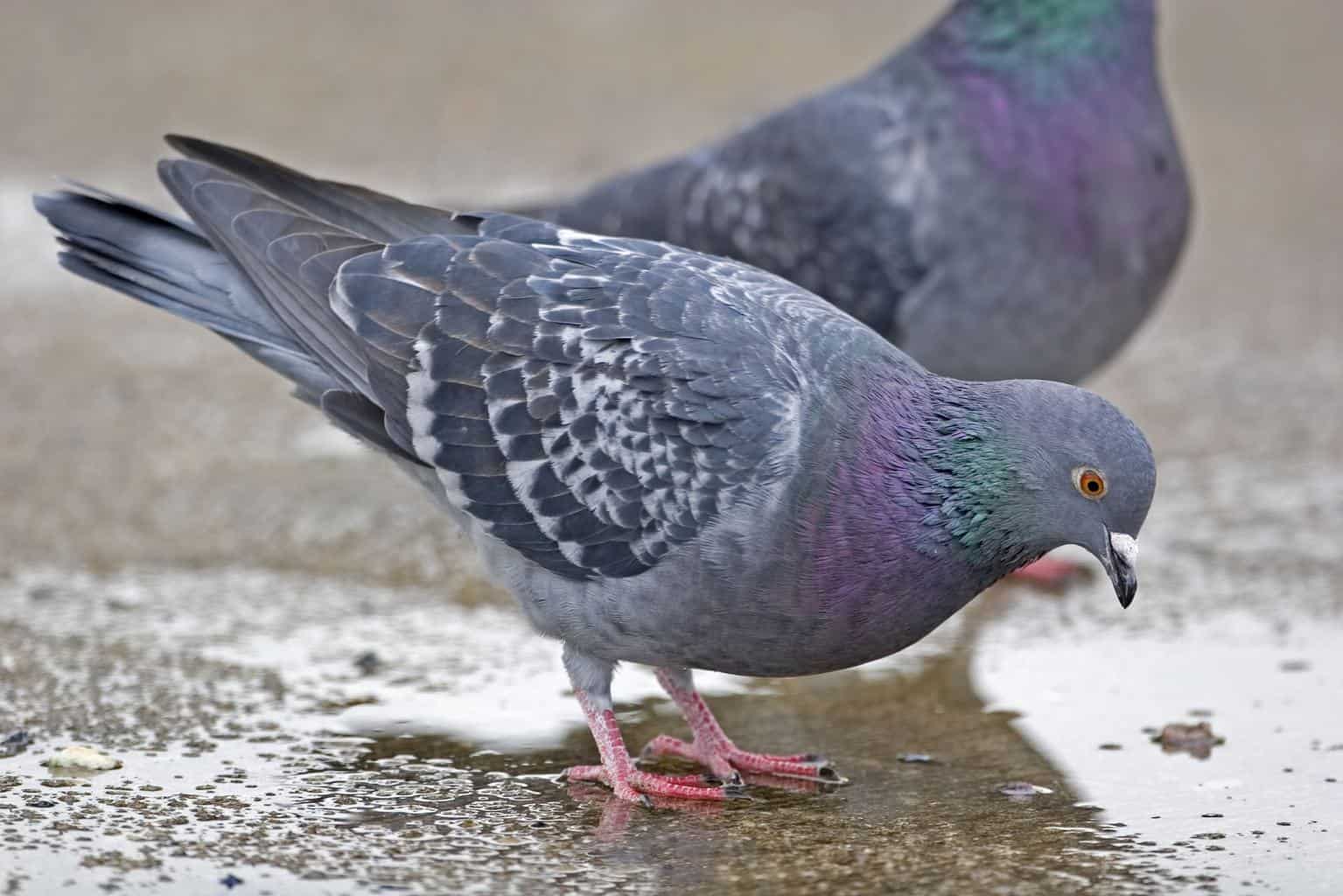
- Scientific Name: Columba livia
- Length: 11.8-14.2 in
- Weight: 9.3-13.4 oz
- Wingspan: 19.7-26.4 in
Not to be confused with the Mourning Dove, Rock pigeons are picturesque birds with well-proportioned bodies, unique colors, and a generally elegant demeanor. If birds had royal ranks, then these pigeons would certainly fancy themselves princes.
Rock pigeons are often foraging for seeds and grit off the ground. They’re not aggressive birds and they’re a bit shy around humans, or any kind of commotion. Once they sense an intrusion into their territory, they take off right away.
They don’t go far from the spot where they were enjoying themselves, though. If you look up in the sky, you’ll notice them circling and observing the goings-on beneath them. And when they feel safe, they’ll return back to where they were.
White-Faced Ibis

- Scientific Name: Plegadis chihi
- Length: 18.1-22.1 in
- Weight: 15.9-18.5 oz
- Wingspan: 35.4-36.6 in
The White-faced Ibis is a large bird that’s mostly rust-colored and has a white color patch on its face. The long curved bill and tall pink legs are probably its most identifying marks.
Non-breeding adults and immature Ibises lack some of these features though. You won’t see the white patch around the eyes, which would make their redness more defined. Also, they have more ruffled feathers around their necks and more subtle, dull colors.
Ibises are often seen in marshes, dipping and probing their bills in the shallow waters. They mainly feed on aquatic invertebrates, and these are rarely in short supply.
Mountain Quail
- Scientific Name: Oreortyx pictus
- Length: 10-11 in
- Weight: 7.4-9.2 oz
- Wingspan: 14-16 in
The Mountain quail belongs to the New World species of quails and is native to North America. These beloved birds are characterized by the lone plume on top of their head. They have a blue-grey head and pale blue and tan body with distinct white markings on their sides.
If you like photography, you’ll want to take a shot of this unique bird. It’s a bit difficult to spot a mountain quail though, even when you can hear its calls loud and clear. That’s because these birds tend to be loners that steer clear from others.
Cedar Waxwing

- Scientific Name: Bombycilla cedrorum
- Length: 6-7 in
- Weight: 1.1 oz
- Wingspan: 8.7-11.8 in
The Cedar Waxwing is another picture-worthy bird. It’s the combination of pastel colors, unique shape, and prominent brown crown that make it stand out. It also has a brownish belly, but that’s not all. It also has strategic black, white, red, and yellow highlights that give it an unmistakable appearance.
Cedar waxwings usually live in forests, and since they feed on fruits, the trees should be a fruit-bearing variety. When they’re not foraging, you’ll often see them gliding in the air sporting some admirable acrobatic moves.
Conclusion
Birdwatching in the Western United States, especially in the State of Idaho is a true adventure. It doesn’t matter if you’re headed north, south, west, or east, you’re bound to come across all types of birds. The summer season is the best time to get out those bird checklists and maybe find an unknown bird or two.
In addition to these 25 unique birds, you might also want to check out the woodpeckers and the hawks in Idaho. On your next bird watching outing, bring your bird lists and a good birding camera with you, and prepare to get some incredible footage and stills of this picturesque wilderness.

